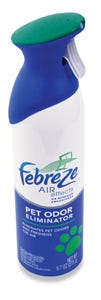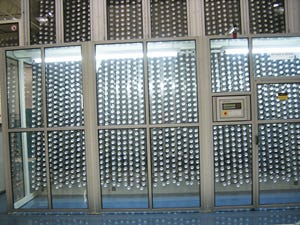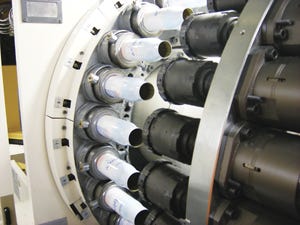January 30, 2014
|
Procter & Gamble (P&G), Cincinnati, OH, has experienced strong growth with its Febreze family of products, most of which are sold in the highly recognizable Febreze can. The cans, which are made with easily recycled aluminum and use a nitrogen propellant, are marketed to consumers looking to put their purchasing dollars behind sustainable products and eco-conscious companies.
Socially responsible manufacturing
EXAL Corp.'s (www.EXAL.com) Youngstown, OH, facility manufactures the cans from 99.7-percent pure aluminum slugs on two of the co.'s 13 impact-extrusion lines.
The plant is part of an international sole proprietorship led by Spanish-born Delfin Gibert, who owns facilities in the U.S., Argentina, France, Holland and Switzerland.
The recently expanded U.S. can-manufacturing plant is built on the brownfields of a bankrupt steel-manufacturing plant, allowing the company to not only reclaim a brownfield, but also to provide manufacturing jobs for Youngstown residents in an eco-friendly business.
The surge in demand for sustainable packaging has served the company well. “We've expanded the first building from 150,000 to 300,000 square feet,” EXAL sales director Susan Chupak explains. “We're still running out of room because we grew so much and our customers grew so much.”
Chrysalizing slugs
More than 7.2 million cans of Febreze Air Effects are produced for the U.S. market alone in any given month. When manufacturing for Canada is considered, this number jumps to nearly 8 million.
To produce the cans, EXAL feeds up to 400 kilograms of slugs into the tumbling equipment at once. These slugs are size-specific, meaning that they are specifically ordered to create a Febreze can with minimal trimming. In a typical day, the manufacturer produces approximately 360,000 Febreze containers from two production lines during two 12-hour shifts.
After the aluminum slug is coated with lubricant, an impact-extrusion press uses a punch to strike it at a high velocity. The slug molds into the shape of the die's cavity. This produces cans free of side seams.
|
After being immersed in a five-stage alkaline-extrusion bath, cans are washed, dried and placed in a work-in-progress buffer |
After extrusion, the can's walls are ironed to straighten and strengthen them. EXAL says that an additional benefit to the wall-ironing process is a smoother surface for better lacquer application and print quality during the lithography process.
Designing for sales
According to Chupak, it is the can's graphics that sell the product on the shelf. “That's what makes it pop out for the customer and adds marketability,” she adds.
P&G has updated the Febreze color palette with the most recent product redesign belonging to Febreze's Pet Odor Eliminator, which relaunched March 2008.
To develop the new color palette, the Febreze team worked with the company's internal research division and external design firm Landor Associates (www.landor.com).
“The color palette is a differentiating factor for Febreze,” assistant brand manager Michael Sabbia explains. “We're giving reassurance to our consumers via colors from our palette,” Sabbia remarks. “For example, the deeper blue cues are more aligned to drive the efficacy message for our odor elimination product line.”
To maximize the differentiating characteristics of the Febreze color palette, P&G did extensively shelf-testing before deciding on the new palette.
Applying color
Before the cans are printed, they are trimmed, bathed, washed and dried. The cans then are sprayed with a polyamide-imide (PAM) resin lining. As part of the qualification process that resulted from work by EXAL's quality engineer Mark Sanders, quality checks with statistical process control (SPC) are performed at every stage of manufacturing, including liner application. Only cans with good lining adhesion move to lithography station, which includes equipment from Mall+Herlan GmbH (www.mall-herlan.de) and Hinterkopf GmbH (www.hinterkopf.de).
|
A series of dies begins to gradually shape the cans’ shoulders. |
A printing process, which uses letterpress and dry-offset technologies, is used to decorate the Febreze cans. “The decorating process is a three-step method that's very similar to painting a car,” says Chupak. “When you paint a can, you put the primer on the car then you put the color on the car, which you let dry. Then you usually put a top-coat to protect the color on the car and to make it have a nice finish. It's the same way with a can.”
A white basecoat is applied to the Febreze cans by the formed cylinder of a coating roller system. The cans then go into a drying oven to cure the basecoat.
EXAL graphics manager Cary Dworek, assistant graphics manager Chris Donegan and graphics employee Donna Holmes image printing plates, which then are registered and mounted onto individual ink stations on the press. Febreze cans are designed to be decorated with seven to nine colors in combination with the base-coat color. The plates pick up and place the inks onto a common blanket.
The common blanket then offsets all colors onto the can in a single pass. Decorated cans are placed into another drying oven for curing.
After the decorated cans are dry, a protective coating of gloss overvarnish is applied to the entire can surface. The cans then go to the last drying oven to cure the overcoat before traveling into the neckdown station for shoulder shaping.
At the neckdown station, the cans are placed in equipment from Italian manufacturer Frattini S.p.A. (www.frattinispa.com). A series of dies reduce the outside diameter of the can into a soft-shoulder shape with a 1-in. outside curl. The cans then are packed for direct shipment to copacker KIK Custom Products (www.kikcorp.com), Elkhart, IN.
More information is available: |
EXAL Corp. , 330/744-2267. www.EXAL.com. |
Frattini S.p.A. , 0-35-29-4170. www.frattinispa.com. |
Hinterkopf GmbH , 49-07-161-8501. www.hinterkopf.de. |
KIK Custom Products, 800/479-6603. www.kikcorp.com. |
Landor Associates, 888/252-6367. www.landor.com. |
Mall+Herlan GmbH, 49-072-194-6010. www.mall-herlan.de. |
About the Author(s)
You May Also Like





